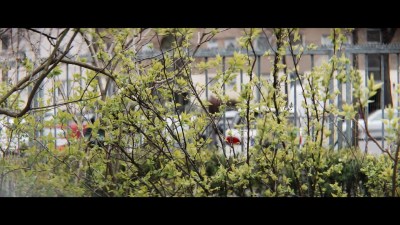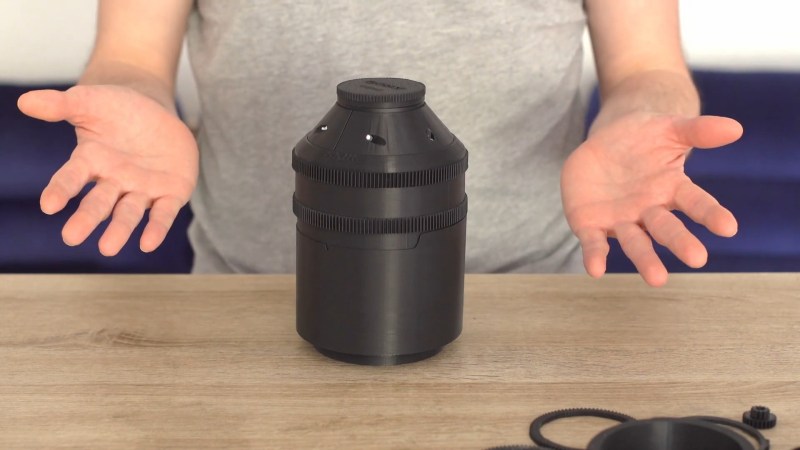Anamorphic lenses are a great way to shoot in widescreen, but they’re prohibitively expensive on digital formats. Enthusiasts have experimented with using anamorphic adapter lenses from old projectors, but focusing can be a chore and results sub-par. [Andrew] found a way to use these cheap old anamorphic adaptors on a modern camera without sacrificing too much functionality.

Anamorphic filming techniques came about in the era of film. The aim was to record cinema-style widescreen footage on 3:2 aspect ratio 35 mm film. The way this was done was by using a lens that squeezes a wide aspect ratio to fit the format, and then a corresponding lens to squeeze it back on the projector. This allows for higher resolution than simply letterboxing onto the 35 mm frame and wasting the extra space.
Adam’s hack involves 3D printing a lens housing that pairs an anamorphic projector adapter lens with a Sony E-mount taking lens. Gears are set up so that both lenses can be focused together, rather than typical adapter setups that require the user to juggle multiple focus rings at once. This makes the rig much more usable in real shoots where there’s no time for messing about.
It’s a useful hack, and one we could imagine quite a few low-budget filmmakers will be rushing out to replicate. Files are on Thingiverse for the eager. Consider whipping yourself up a camera slider while you’re at it for really boss shots. Video after the break.
















A very general instruction about very specific parts. Great work!
I don’t see me replicating this though, as I probably can’t get hold of these specific lenses.
Don’t let me hold back anyone to do this, I love this kind of tinkering :) Great end result :)
I’m Andrew, this is my project. The way I designed it, it’s actually pretty easy to adapt to other lenses and since a bunch of people asked, I’ll be creating another video explaining the whole design process.
Looks great but now cue the most annoying portrait mode videos ever, posted on youtube, recorded in panavision with a 1:2.39 aspect ratio!
I’m feeling exceptionally lazy at the moment.
Great project, thoroughly impressed. Now if it would provide me with the motivation to wrap up one or two of mine…
Second the great project. There’s an excellent YouTube clip on anamorphic lenses by Media Division:
https://www.youtube.com/watch?v=bIhaItLnSR0
Ha, nice try. You think you’re going to get me to watch that whole thing and then spend years of my life hunting down old glass on eBay and trying to replicate a never quite attainable look only to eventually realize that like with stills photography, I just don’t have the training and the eye to make a shot worth looking at?
You almost had me.
Find a locally owned lens shop; that way you can just leave a wish list and have then call when they get neat stuff.
I don’t know how my dealer has been doing with the pandemic, he’d already branches out into LPs at his son’s advice, it really helped, and being just a block off campus didn’t hurt. When I could drop by once a month, I had the pick of newly found Minolta stuff. He would hit estate sales and auctions, and had other small business owners who knew if they bought a storage locker he would take any photography stuff. Never could get him to lower the price on the Hasselblad body he had got for next to nothing.
Don’t expect good quality from these projection lenses. They were made to project on a flat surface so all lens corrections are based on that assumption. Now you are using them in 3d space. Expect some abberations in tje out of focus areas of the frame.
But of course that can also be the look you are looking for, like “bokeh”.
At the risk of sounding rude, do you actually know anything about anamorphic lens design or are you talking out of your ass? There are different ways to measure quality. If you’re talking about optical resolution, then it depends a lot of matching the right taking lens to the adapter. The Helios seems like a pretty good match and up to 4k I’ve been very happy with the resolution, sharpness and contrast. If you’re talking about the focus fall off, smeared and slightly distorted out of focus areas, oval bokeh, horizontal light streaks, etc., those are the ENTIRE reason to shoot with vintage anamorphics.
This is super sick work.
I did something similar in a very, very rudimentary way, making a 3d printed sleeve where my variable diopter screwed on the front of it. You couldn’t adjust the aperture unless you took the whole thing apart though, so it became something related to a closet somewhere. This is very encouraging though. Very ready to look at your design files if you upload them.
The files are online if you want to check them out. Unfortunately it’s a blend file, since I never bothered to learn CAD. You can check it on thingiverse https://www.thingiverse.com/thing:4832093
I’d also be interested in seeing the sleve you built, if you ever want to post some information on it.